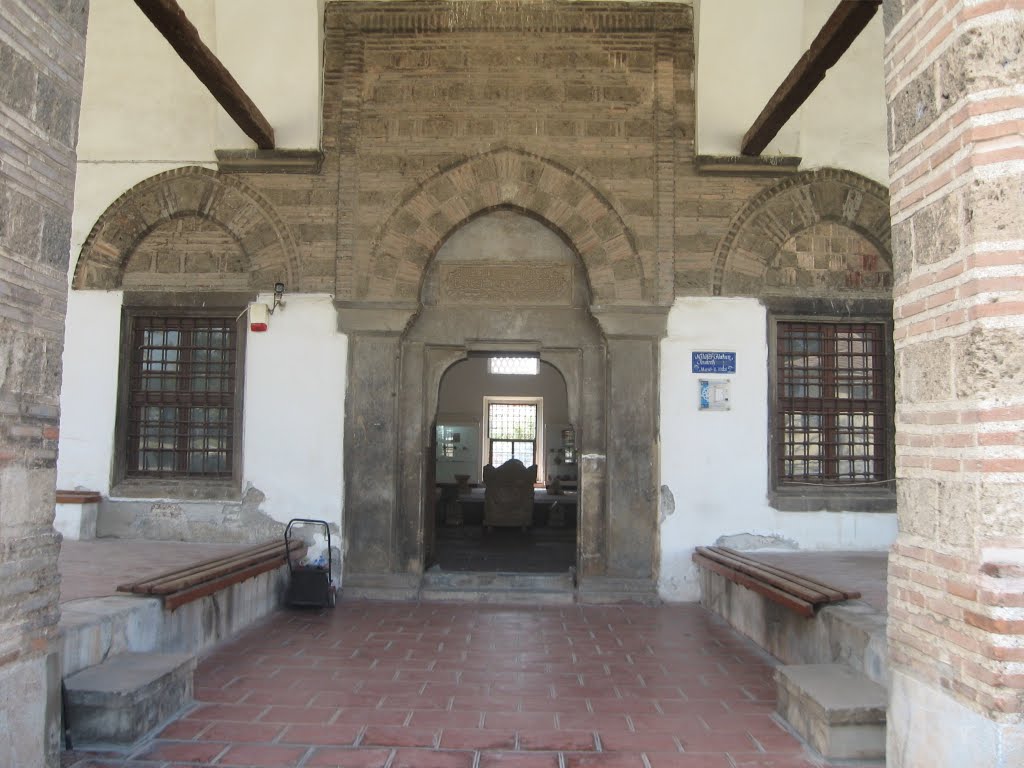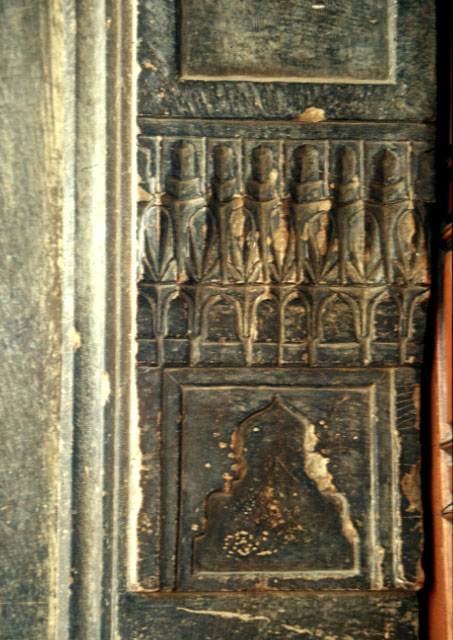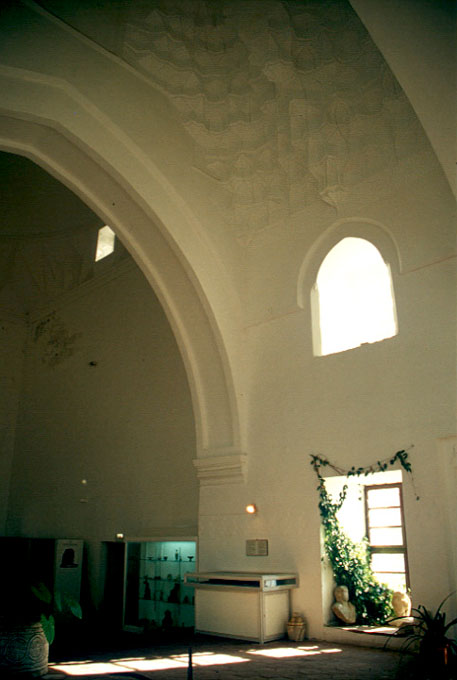Nilüfer Hatun Imareti on:
[Wikipedia]
[Google]
[Amazon]
 Nilüfer Hatun Imareti (Turkish for "Nilüfer Hatun Soup Kitchen"), a convent annex hospice for
Nilüfer Hatun Imareti (Turkish for "Nilüfer Hatun Soup Kitchen"), a convent annex hospice for
, or Queen Mother, the first in Ottoman history to hold this title, and when she died she was buried beside Orhan Gazi and his father Osman Gazi in Bursa. The Muslim traveler 

 The Imaret is built in single courses of stone alternating with four courses of bricks, its vaults and domes covered with ceramic tiles. The building is preceded by an open ended porch of five bays, with five arches in front and two on either side, carried by a succession of alternating piers and columns. The central bay is surmounted by a small dome, while the four side bays are covered with flat topped cross vaults. Inside, the main hall is a square surmounted by a lofty dome carried on the belt of Turkish triangles. On either side there are two large rooms with much lover domes; these have large , or hearths, and were used as both kitchens and dormitories. In front of the main hall is another hall of similar size divided into two sections by a great arch; this served as a mescit, as evidenced by the mihrab niche in the south wall.
The Imaret is built in single courses of stone alternating with four courses of bricks, its vaults and domes covered with ceramic tiles. The building is preceded by an open ended porch of five bays, with five arches in front and two on either side, carried by a succession of alternating piers and columns. The central bay is surmounted by a small dome, while the four side bays are covered with flat topped cross vaults. Inside, the main hall is a square surmounted by a lofty dome carried on the belt of Turkish triangles. On either side there are two large rooms with much lover domes; these have large , or hearths, and were used as both kitchens and dormitories. In front of the main hall is another hall of similar size divided into two sections by a great arch; this served as a mescit, as evidenced by the mihrab niche in the south wall.
 Nilüfer Hatun Imareti (Turkish for "Nilüfer Hatun Soup Kitchen"), a convent annex hospice for
Nilüfer Hatun Imareti (Turkish for "Nilüfer Hatun Soup Kitchen"), a convent annex hospice for dervishes
Dervish, Darvesh, or Darwīsh (from fa, درویش, ''Darvīsh'') in Islam can refer broadly to members of a Sufi fraternity (''tariqah''), or more narrowly to a religious mendicant, who chose or accepted material poverty. The latter usage i ...
, now housing the Iznik Museum in İznik
İznik is a town and an administrative district in the Province of Bursa, Turkey. It was historically known as Nicaea ( el, Νίκαια, ''Níkaia''), from which its modern name also derives. The town lies in a fertile basin at the eastern end ...
, Bursa Province, Turkey. This elegant building was erected in 1388 for Murat I
Murad I ( ota, مراد اول; tr, I. Murad, Murad-ı Hüdavendigâr (nicknamed ''Hüdavendigâr'', from fa, خداوندگار, translit=Khodāvandgār, lit=the devotee of God – meaning "sovereign" in this context); 29 June 1326 – 15 Jun ...
who dedicated it to his mother.
When Orhan Gazi was off on campaign Nilüfer acted as his regent, the only woman in Ottoman history who was ever given such power. During Murad's reign she was recognized as Valide Sultan #REDIRECT Valide sultan #REDIRECT Valide sultan
{{redirect category shell, {{R from move{{R from miscapitalization{{R unprintworthy ...
{{redirect category shell, {{R from move{{R from miscapitalization{{R unprintworthy ...Ibn Battuta
Abu Abdullah Muhammad ibn Battutah (, ; 24 February 13041368/1369),; fully: ; Arabic: commonly known as Ibn Battuta, was a Berbers, Berber Maghrebi people, Maghrebi scholar and explorer who travelled extensively in the lands of Afro-Eurasia, ...
, who visited Iznik in the 1330s, was a guest of Nilüfer Hatun, whom he described as 'a pious and excellent woman'.

Architecture

 The Imaret is built in single courses of stone alternating with four courses of bricks, its vaults and domes covered with ceramic tiles. The building is preceded by an open ended porch of five bays, with five arches in front and two on either side, carried by a succession of alternating piers and columns. The central bay is surmounted by a small dome, while the four side bays are covered with flat topped cross vaults. Inside, the main hall is a square surmounted by a lofty dome carried on the belt of Turkish triangles. On either side there are two large rooms with much lover domes; these have large , or hearths, and were used as both kitchens and dormitories. In front of the main hall is another hall of similar size divided into two sections by a great arch; this served as a mescit, as evidenced by the mihrab niche in the south wall.
The Imaret is built in single courses of stone alternating with four courses of bricks, its vaults and domes covered with ceramic tiles. The building is preceded by an open ended porch of five bays, with five arches in front and two on either side, carried by a succession of alternating piers and columns. The central bay is surmounted by a small dome, while the four side bays are covered with flat topped cross vaults. Inside, the main hall is a square surmounted by a lofty dome carried on the belt of Turkish triangles. On either side there are two large rooms with much lover domes; these have large , or hearths, and were used as both kitchens and dormitories. In front of the main hall is another hall of similar size divided into two sections by a great arch; this served as a mescit, as evidenced by the mihrab niche in the south wall.
Uses and restoration
The building originally served as a hostel for the Ahi Brotherhood of Virtue. This was a religious and fraternal society formed by the craft guilds inAnatolia
Anatolia, tr, Anadolu Yarımadası), and the Anatolian plateau, also known as Asia Minor, is a large peninsula in Western Asia and the westernmost protrusion of the Asian continent. It constitutes the major part of modern-day Turkey. The re ...
during the Seljuk period. Ibn Battuta also wrote about the hospitality her received at one of the Ahi lodges in Anatolia.
Nilüfer's foundations was later used as an imaret, or refectory, serving free food to the poor of Iznik. The building was abandoned for many years but was restored in 1955.. Today it houses the Iznik Museum, with archaeological and ethnological collections, including an exhibition of the famous Iznik kilns.
See also
*Ottoman Empire
The Ottoman Empire, * ; is an archaic version. The definite article forms and were synonymous * and el, Оθωμανική Αυτοκρατορία, Othōmanikē Avtokratoria, label=none * info page on book at Martin Luther University) ...
*Nilüfer Hatun
Nilüfer Hatun ( ota, نیلوفر خاتون, birth name Holifere ''(Holophira)'' / Olivera,. other names ''Bayalun, Beylun, Beyalun, Bilun, Suyun, Suylun'') was a Valide Hatun; the wife of Orhan, the second Ottoman sultan. She was mother of th ...
*Murad I
Murad I ( ota, مراد اول; tr, I. Murad, Murad-ı Hüdavendigâr (nicknamed ''Hüdavendigâr'', from fa, خداوندگار, translit=Khodāvandgār, lit=the devotee of God – meaning "sovereign" in this context); 29 June 1326 – 15 Jun ...
*Ottoman Architecture
Ottoman architecture is the architectural style that developed under the Ottoman Empire. It first emerged in northwestern Anatolia in the late 13th century and developed from earlier Seljuk architecture, Seljuk Turkish architecture, with influen ...
References
{{DEFAULTSORT:Nilufer Hatun Imareti Museums in Turkey Buildings and structures of the Ottoman Empire